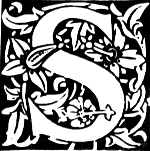
|
Medieval Knitting Notes
Updated
11 August 2013
|
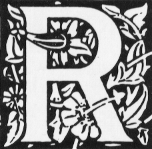
|
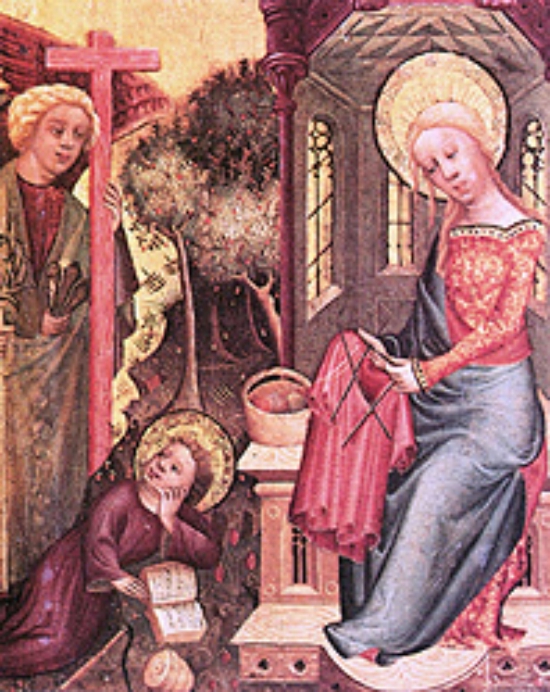
The earliest examples of true knitting anywhere in the world are Egyptian, dating to no earlier than the 1000s. They are circular knitted multi-color stranded knitting in fairly fine gauges so experts believe that knitting was invented somewhat earlier than our earliest surviving examples.
Examples of "knitting" purported to be earlier than the 1000s have so far all turned out to be naalbinding, sprang or other such techniques that give results superficially resembling knitting. The term "knitting" is a late arrival into the English language (as it is in all other languages - details?) supporting a relatively late development of the technique.
There is solid evidence of knitting in Europe by the 13th century.
General Sources:
biti-Anat, Lilinah. Dar Anahita website with several articles on Medieval Muslim Knitting. http://home.earthlink.net/~urtatim
HistoricKnit Yahoo Group discussions
Laning, Chris. "Medieval Knitting." Tournaments Illuminated 165, 7-08-08. http://
Theaker, Julie. "The History of Knitting." http://www.knitty.com/ISSUEspring06/FEAThistory101.html
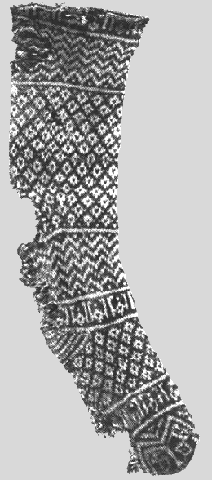
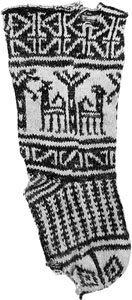
Egyptian Socks
Provenance: 11-14th cent. from what is now Cairo, Egypt
Fiber: fine two-ply cotton or very fine two-ply wool, wool items often use cotton for white areas
Colors, Cotton: white, shades of indigo
Colors, Wool: madder red, indigos, ochre yellow, creamy yellow, fugitive green, occ. fugitive purple
Gauge: 10-14 stitches per inch
Technique: knitted in the round, knit-face, toe-up, various heel and shaping techniques
Child's Sock: diamond toe; short row heel; 2-color stranded patterning; simple bind off, possibly figure-8 cast-on
Description and Notes: often patterned with two colors in a row, occ. with a third color in bands, wool pieces may use six colors or more and sometimes more than three colors per row
Recreation Notes:
For the child's socks, Anahita resorted to 4-ply cotton, S-plied of Z-spun strands (Baby Georgia, made by Crystal Palace) but noted that it had more plies and was more tightly spun than the original. With Size 1 needles she got 10 stitches per inch.
Sources:
Egyptian Sock - http://home.earthlink.net/~urtatim/EgyptKnit1.html
Child's Sock - http://home.earthlink.net/~urtatim/Ibex_Sox-docu.html

Egyptian Mystery Object
Provenance: 11-13th century, Egypt
Fiber: 2 S-plies of Z-spun cotton
Colors: natural and two shades of indigo
Gauge: 15 stitches per inch
Size: 20cm x 3cm (8in x 1.5in)
Technique: knitted in the round, knit-face, likely top-down
Description and Notes: possibly used as a coin pouch, colors are rather uneven either due to dying technique or the passage of time
Recreation Notes:
Anahita used DMC Gradated Perle Cotton (and Embroidery Floss to get gradated dark blue) on No. 1 glovers (extra short) needles to get 12 stitches per inch, but says she should have used thinner needles.
Sources:
Mystery Object - http://home.earthlink.net/~urtatim/MysteryObj.html
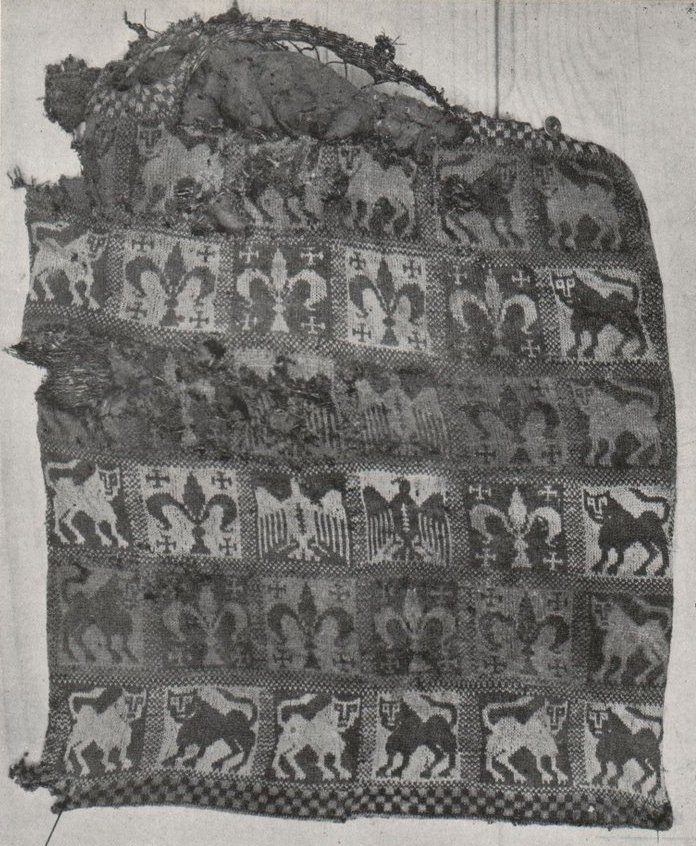
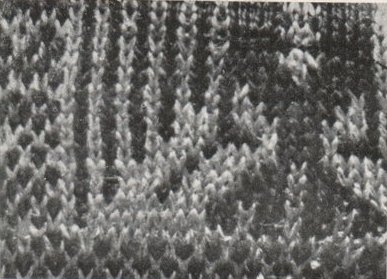
Spanish Pillow
Provenance: 13th century (1275?), Monastery of Las Huelgas near Burgos, Spain?
Fiber: silk (wool per Gomez but apparently wrong)
Colors: red, cream, gray
Gauge: 20 stitches per inch? (Dar Anahita?)
Size: 28cm
Technique:
Description and Notes:
Spain was controlled by the Muslim Moors and some pieces of 13th century Spanish knitting have clear Muslim influence
Source:
Medieval Silkwork Blog - http://m-silkwork.blogspot.com/
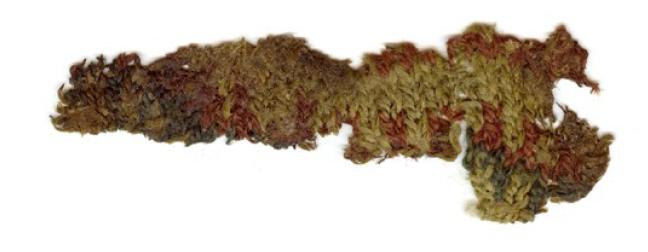
Estonian Mitten
Provenance: 13th century, found in Votic cemetery in Jouga, Estonia in 1949
Fiber: local wool - worsted, z-spun singles s-plied into 1.4mm thick yarn
Colors: natural, madder-dyed, and indigo (blue yarn actually blended with natural white 50/50)
Gauge: 2.5 stitches/3 rows per cm (6-8 stitches per inch)
Technique: knit using Eastern method (i.e. stitches lay on the needles open to the right), stranded, probably knit in the round although fragment too small to determine for certain
Description and Notes: fragment found in a woman's burial near her hands and therefore determined to be a mitten - possibly the cuff, pattern is a symmetrical "comb" pattern on a white background;
Source:
Lyffland, Anneke. "A Study of a 13th-Century Votic Knit Fragment." http://2cinquefoils.net/anneke/13thC-knit-fragment.pdf
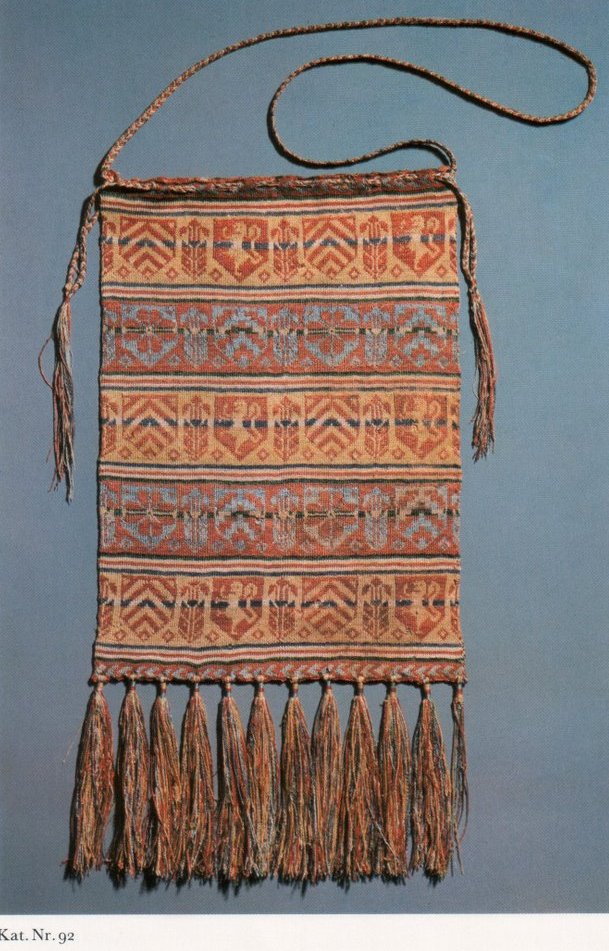
Germanic Pouches
Chur Purse
Provenance:
Fiber: silk (with some wool according to Rutt?)
Colors: blue, white, red
Gauge: 7 stitches per inch?
Size: 34cm tall and 24.5cm wide.
Technique:
Description and Notes: three rows of red motifs on a beige ground, and two rows of light blue motifs on a red ground, in the middle of each row of there is a contrasting horizontal stripe - blue-on-white in the red-motif rows and beige-on-green in the blue-motif rows, also narrow horizonal stripes between the rows - three dark and two light (blue, white, red, white, blue).
Sources:
"FO, Chur Relic Purse." Beauty Isn't Perfect Blog. http://beautyisntperfect.blogspot.com/2009/04/fo-chur-relic-purse.html
Laning, Chris. Message on HistoricKnit Yahoo! Group.
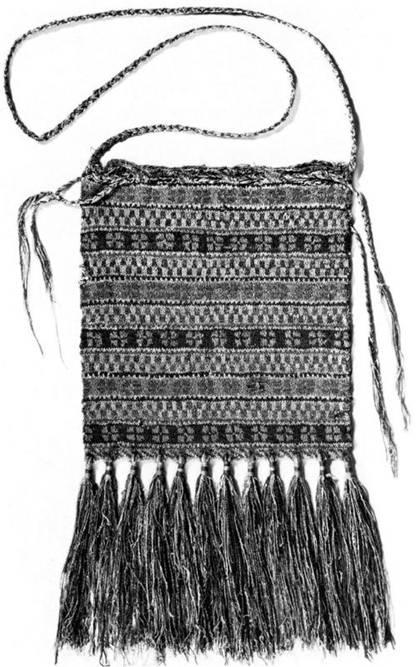
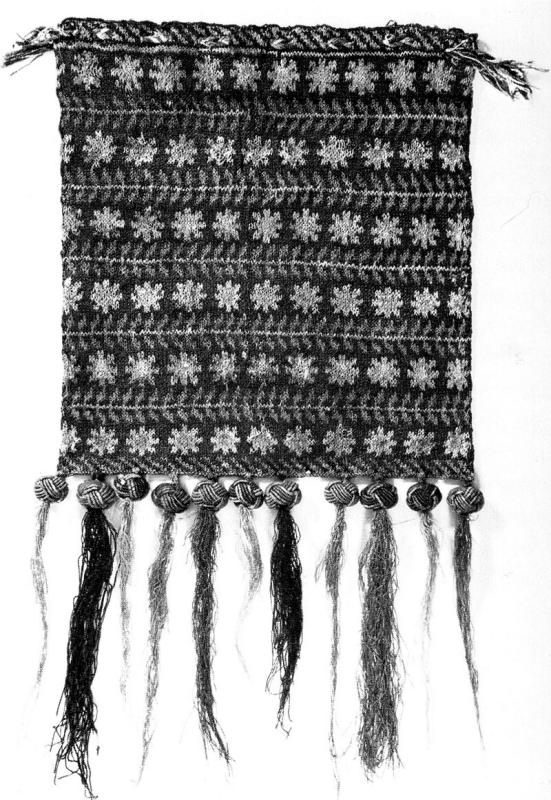 Sion Pouches
Sion Pouches
Provenance: c. 14th century, treasury of cathedral in Sion, Switzerland
Fiber: silk
Colors: red, green, blue, violet, beige, white
Gauge: 16 stitches to the inch
Size: vary from roughly 8.1-13.3 inches long and 6.25-10.3 inches wide
Technique:
Description and Notes: pouches are lined, have 9-14 tassels along the bottom, tops closed with two finger-loop-braided drawstrings with a separate hanging cord.
Replica Notes:
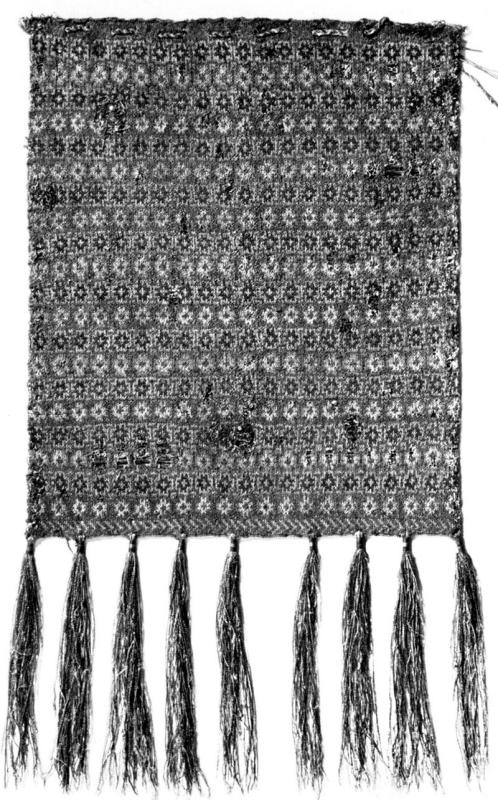
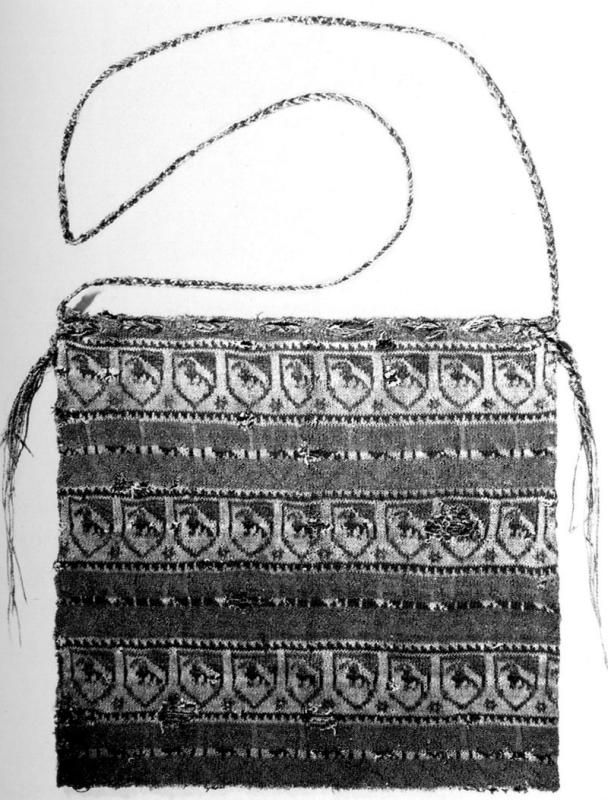
Lady Sof'ia Serafimskaia used size FF Champion Silk Thread on size 0000 needles to get the required 16 stitches/inch gauge.
THL Lucia Thaylur used Zephyr (Jagger Spun) 50/50 Chinese Tussah Silk/Merino wool on 00000 (1.75mm) needles to get 16-20 stitches per inch.
Ursula Georges used silk yarn (size not given) on 00 needles (?!?) to get 7 stitches/cm (approx. 17 st. per inch).
I've been using No. 5 DMC Crochet cotton on 00 needles to get 11 stitches per inch.
Sources:
Georges, Ursula. "Fourteenth-Century Relic Pouch." http://www.doomchicken.net/~ursula/knitting/relicpouchdocumentation.shtml
Medieval Silkwork Blog - http://m-silkwork.blogspot.com/
Saladini, Susan. "Silk Sion Purse: Hand Knitted Reliquary Purse Documentation and Pattern." http://spindlesend.net/sionsilkpurse.htm
French Pouch
 Provenance: 13th century, French
Provenance: 13th century, French
Fiber:
Colors:
Gauge:
Technique:
Description and Notes: 14.5 cm wide and 12.5 cm high, mentioned in Ursula George's article about her Fourteenth Century Relic Pouch - same as the Sens Pouch?
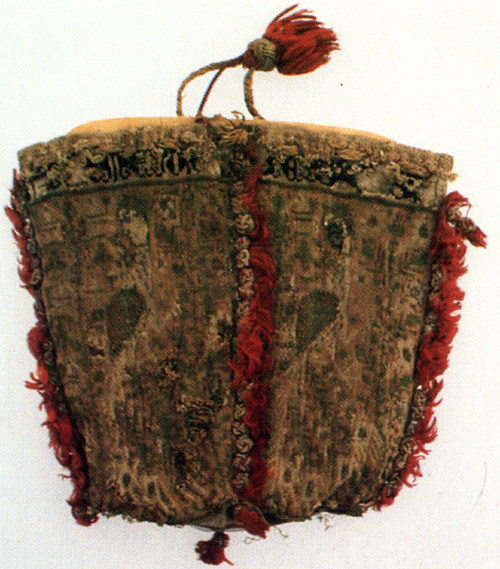
Sens Knit Pouch
Provenance: 13th Century
Fiber: black, white, dark and light brown, slate blue, dark slate blue, red silk and gold thread
Colors:
Gauge: Maybe 10-12 stitches per inch
Technique: knitted top to bottom, cord is a simple 3-strand braid ending in a "Turk's Head" type knot,
Description and Notes: divided in 4 panels,
Source:
Jones, Heather Rose. "Knit purse held at Sens cathedral museum n France." HistoricKnit Yahoo! Groups Files.
Germanic Gloves
 Provenance: 1297
Provenance: 1297
Fiber:
Colors:
Gauge:
Technique:
Description and Notes:
Knitters had contrived to produce gloves by the 13th century. The Cathedral of St. Sernin in Toulouse, France, houses a pair of plain white knitted gloves. Fragments of gloves from Bonn, Germany, interred with Bishop Siegfried von Westerburg in 1297... http://www.free-article-directory.com/Art/11533/28/A-Historical-View-Of-Knitting-Gloves-And-Baby-Clothes.html
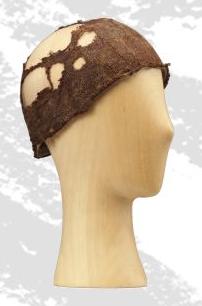
Byssus Cap
Provenance: early 14th century, Saint-Denis, France
Fiber: byssus, "sea silk" from a type of mussel
Colors: natural brown with gold highlights
Gauge:
Technique: stocking stitch
Description and Notes:
Source:
http://www.saint-denis.culture.fr/en/vignet_fich1.htm
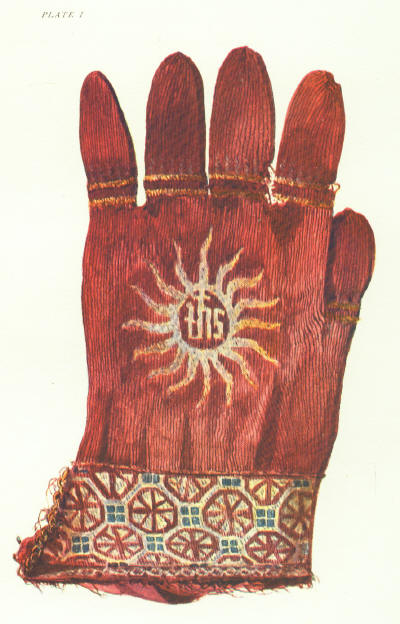
English Bishop's Gloves
Provenance: c. 1386
Fiber: very fine red silk with metallic thread
Colors: see above
Gauge:
Technique:
Description and Notes:
The left-hand glove of a pair of great interest and beauty, and, taking into consideration their age (517 years), in a wonderful state of preservation; they are made of crimson, purl knitted, silk, embroidered on the backs and cuffs with gold, now faded and tarnished. The octagon designs round the cuffs are separated by small squares of green silk; a double band of gold embroidery encircles each finger and thumb. The entire length of the gloves from the tip of the middle finger to the edge of the cuff is 9¾ inches. The cuffs are lined with crimson silk: the circles on the back of the hand, with their sixteen flame-pointed arms worked in gold, surround the sacred monogram.
These early ecclesiastical gloves belonged to William of Wykeham, Bishop of Winchester, the founder of New College, Oxford (originally designated St. Mary’s College of Winchester in Oxenford), in 1379, and were probably worn by him at the opening religious ceremonial, April 14th, 1386.
They are carefully preserved in the Treasury of New College, Oxford.
Source:
http://www.personal.utulsa.edu/~marc-carlson/histshoe/redfern/GLOVES/plateI.htm
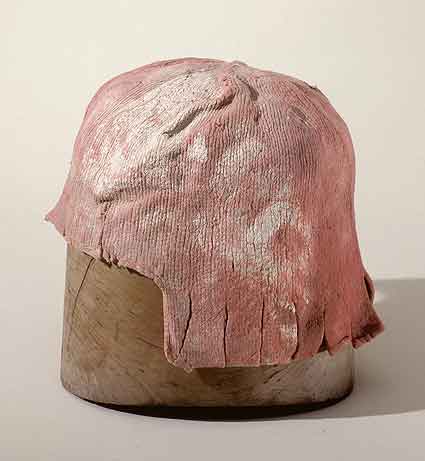
Basel Stone Mason's (?) Cap
Provenance: c. 1460, Basel, found during restoration work at St. Leonhards-Kirche
Fiber: wool
Colors:
Gauge:
Size: Kopfumfang (circumferance?) 62 cm
Technique:
Description and Notes: Historische Alltags- oder Arbeitskleidung ist leider selten erhalten. Ohne speziellen Auftrag, wie ihn allenfalls
die Volkskunde wahrnimmt, wird ihr in den Museen kaum Beachtung geschenkt. Die Kappe wurde bei Restaurierungs-
arbeiten unter dem Lettner-Holzboden in einem Trichter eines Kreuzgewölbes der Basler St. Leonhards-Kirche gefunden. Es handelt sich wohl um die Kopfbedeckung eines Steinmetzen: Eine zeitgenössische Darstellung eines Steinmetzen auf einem Schlussstein im Gewölbe des Altar-
raums im Berner Münster zeigt die gleiche rote Kappenform. Solche Kappen wie auch die damals modischen Barette waren Produkte der "Barettlimacher", die wie die "Lismer"
(Stricker) Mitglieder der Herrenzunft zu Safran waren. Wie heute noch die nordafrikanischen kalottenförmigen Chechias wurden sie mit Wollgarn locker und übergross in Form gestrickt und anschliessend durch Waschen in Lauge und mechanisches Walken zur endgültigen Gestalt verdichtet. Die Zaddeln der Kappe sind nachträglich vom Besitzer eingeschnitten worden.
Machine Translation: Historical everyday life or work clothes is kept unfortunately rare. Without special order, like it if necessary the folklore notices, it in the museums hardly attention is given. The cap became with restoration work under the Lettner timber flooring in a funnel of a Kreuzgewölbes of the Basler pc. Leonhards church found. It probably concerns the head coverage stone-cutters: A contemporary representation stone-cutters on a Schlussstein in the Gewölbe of the altar area in Bernese Münster shows the same red cap form. Such caps like also the then fashionable toques were products " Barettlimacher" , those as " Lismer" (Stricker) members of the gentleman guild to Safran were. As today still the North African kalottenförmigen Chechias was knitted it with Wollgarn loosely and extra large in form and consolidated afterwards by washing in caustic solution and mechanical milling to the final shape. The Zaddeln of the cap was later cut by the owner.
Sources:
http://www.hmb.ch/ServiceBroker?PAGEID=463
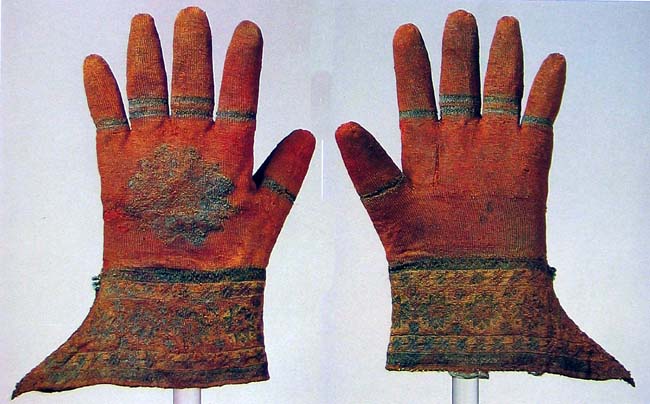
Nicolaus Shimer Bishop's Gloves
Provenance: early 16th Century, 1510
Fiber: very fine red silk with metallic thread
Colors: see above
Gauge:
Technique:
Description and Notes:
From "The Knitted Textile Treasures of Sion" in the HistoricKnit Yahoo! Group Files: "Sion also contains excellent examples of early “inconsutilis” or bishops gloves.
A pair were found in the tomb of Bishop Nikolaus Schiner of Sion , from the 15th [sic] Century. These were knitted in very fine red silk with a metallic thread pattern. The pattern giving a ringer effect to the fingers of the gloves and the back is decorated with a eight point star, the side seam is decorated with metallic knits. These gloves were conserved by gentle washing and dried on stuffed plastic gloves, they are presented in their conserved state on dyed tricot-knit gloves to give support to the gloves and damaged parts which are stitched to the support."
See also:
http://www.kostym.cz/Anglicky/2_Detaily/01_Doplnky/II_01_42.htm
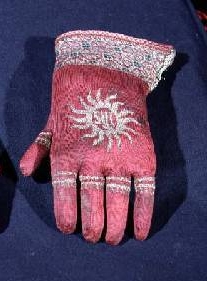
William Warham Bishop's Gloves
Provenance: 16th Century
Fiber: very fine red silk with metallic thread
Colors: see above
Gauge:
Technique:
Description and Notes:
See also:
http://www.kostym.cz/Anglicky/2_Detaily/01_Doplnky/II_01_79.htm
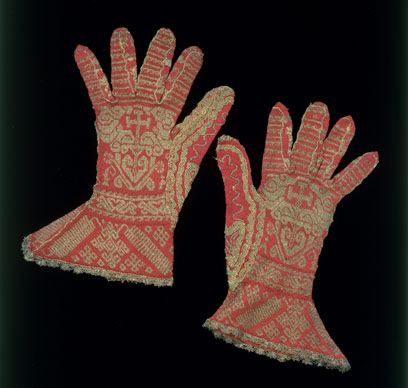
Spanish Liturgical Gloves
Provenance: 16th Century, Victoria & Albert Museum
Fiber: silk and silver strip
Colors: red and yellow-wrapped-with-silver
Gauge:
Technique: stocking stitch, knitted in the round, with the second thread woven into the back of the stitches so that the inside is neatly finished. The thumb was knitted separately, also in the round, and there is a diamond-shaped gusset between the thumb and index finger.
Description and Notes:
These Spanish gloves are an early example of European knitting as few pieces survive prior to the 16th century. The earliest knitted objects are found in Spain, and we think the craft was introduced via Islamic culture from North Africa.
These gloves were made for a bishop and are decorated with religious symbols. These include a cross surmounting a heart, a shepherd's crook or bishop’s crozier to the left, and a reliquary to the right. The cuffs are patterned with geometric designs and a Greek wave motif appears on the fingers and wrist. The silver-gilt bobbin lace and plaited braid applied to the fingers gives the appearance of the seam lines in sewn leather gloves.
http://collections.vam.ac.uk/item/O107792/pair-of-gloves/
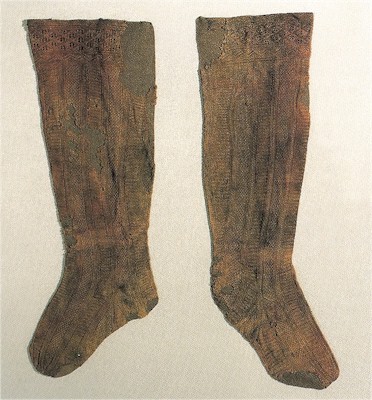
Eleanor of Toledo Stockings
Provenance: 1562,
Fiber: silk
Colors:
Gauge:
Technique:
Description and Notes:
Source: http://realmofvenus.renaissanceitaly.net/workbox/extwomacc1.htm
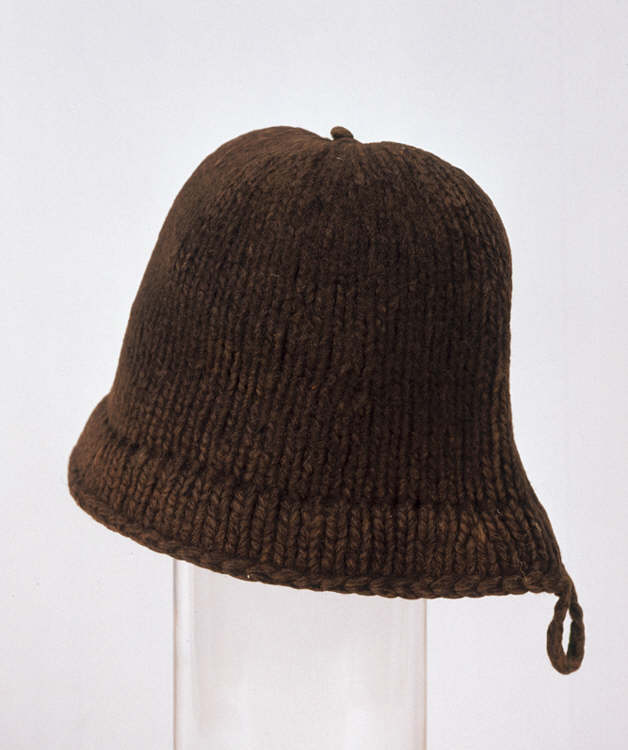
Monmouth Cap
Provenance: 16th century, Nelson Museum and Local History Centre
Fiber: two-ply wool
Colors:
Gauge: 2.5 stitches/inch
Technique: cast on at outer edge, knitted to the top, then stitches are picked up on the inside and knitted down to make a second inner layer for the brim, the edge is cast off with a 3-needle bind-off with the cast-on edge.
Description and Notes: 59 stitches around where the brim meets the crown,
Replication Notes:
HistoricKnit discussion recommends size 11 or 13 needles (8 or 9mm) with "bulky" or "chunky" yarn, using 3 needles and a 4th working needle. Brim is 8 stitches tall with a slight (3 stitch decrease) partway up. Crown goes up straight about 9 rows, then decreased slightly (3 stitches) on the 10th row, on the 20th row (or so) decrease again by 3 but in a different place on the needles, decrease 3 stitches again on the 30th row. To close the crown, every other row decreases either every 3 stitches or every 2 stitches (k3, k2tog vs k2, k2tog) until there are only 8 stitches left. Draw the yard through those eight and tighten. Optional if the top pokes up a bit in a peak to wrap it into a "button" or "tag" at the top. Then go back to the top of the brim (row 8) and pick up the purl bumps on the inside, then knit your eight rows remembering to increase by 3 stitches where you decreased originally. Match the edges so there's no twist and cast-off the edges together. At the end make a 14-loop finger chain and fasten into a loop, weaving in the ends. Felt as desired.
My version used size 8 needles with [size?] wool yarn and was knit at a finer gauge than the original and I didn't bother with the "button" or the loop. I haven't felted mine, yet. I like the relatively loose fit - no "hat head" when I get to work in the morning.
Sources:
HistoricKnit Yahoo!Groups files
"Monmouth Cap, 16th Century." Gathering the Jewels, the website for Welsh Cultural History. http://www.gtj.org.uk/en/small/idem/GTJ01788/
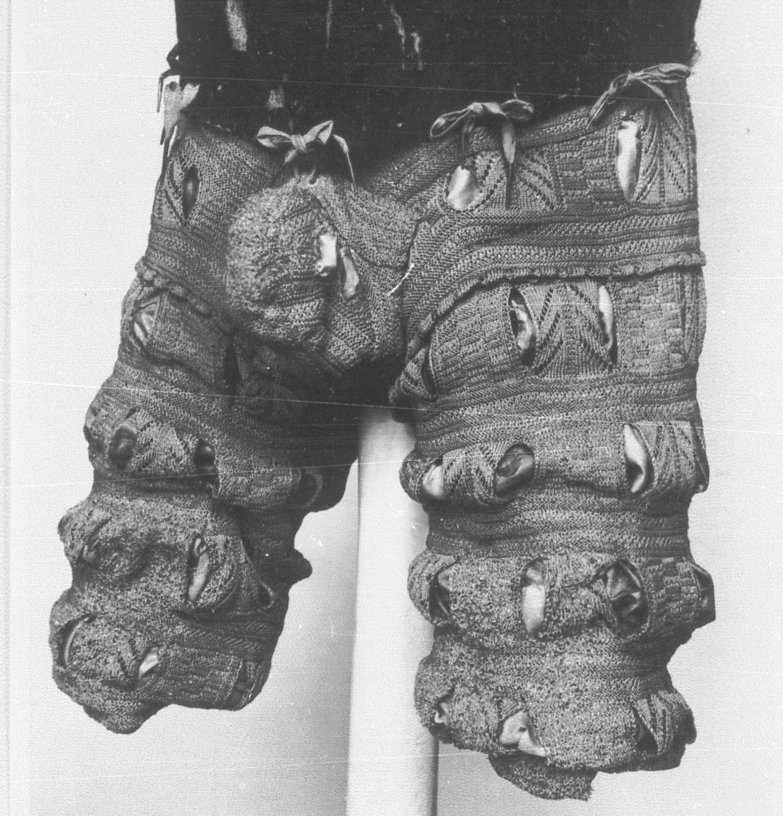
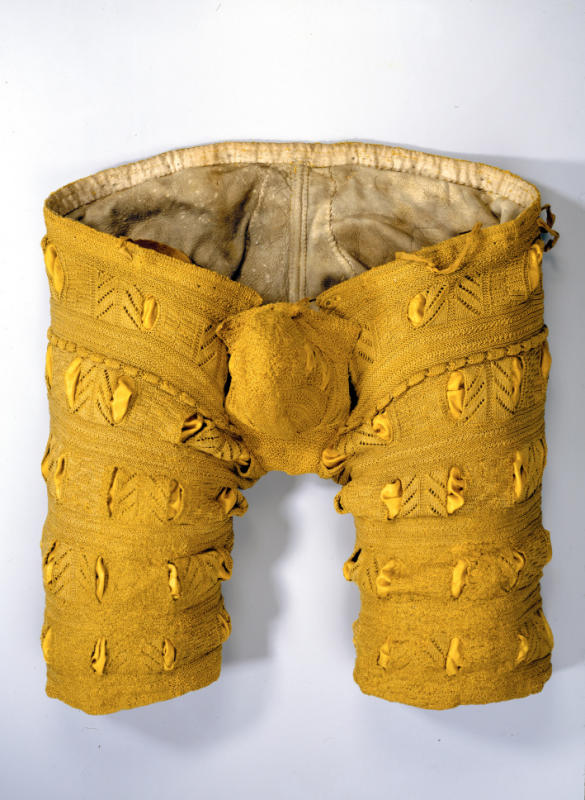
German Trousers/Dresden Trunk Hose
Provenance: 15th or 16th Century
Fiber:
Colors:
Gauge:
Technique:
Description and Notes:

Berets and other items from the Mary Rose
Provenance: sank in 1545
Fiber: wool
Colors:
Gauge:
Technique:
Description and Notes: Three woollen knitted hats resembling flat brimmed berets have been recovered. Two of these are intact and have silk linings. Another knitted item recovered virtually complete is a scogger, a versatile sleeve rather like a modern legwarmer that could be worn either on the arm or lower leg.
Source: http://www.maryrose.org/life/cloth2.htm
http://www.curiousfrau.com/patterns/knitting-patterns/93-recreating-the-gagiana-barett
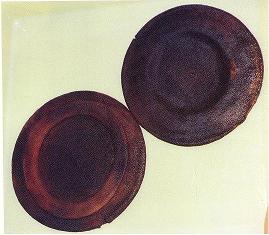
Hat from the Gagiana
Provenance: the Gagiana sank in 1583 off the coast of Croatia on a voyage to the east from Venice
Fiber: wool
Colors: dark brown or black
Gauge: 2sts = 1cm, 3 rows = 1cm (i.e. 5 sts/7.5 rows per inch)
Technique: knitted and then fulled
Description and Notes: compare to multiple similar examples at the V&A, etc.
Sources:
http://www.curiousfrau.com/diaries/50/94
http://www.curiousfrau.com/patterns/knitting-patterns/93-recreating-the-gagiana-barett
Send comments and questions to lkies319@gmail.com
Return to Home Page.









 Sion Pouches
Sion Pouches








